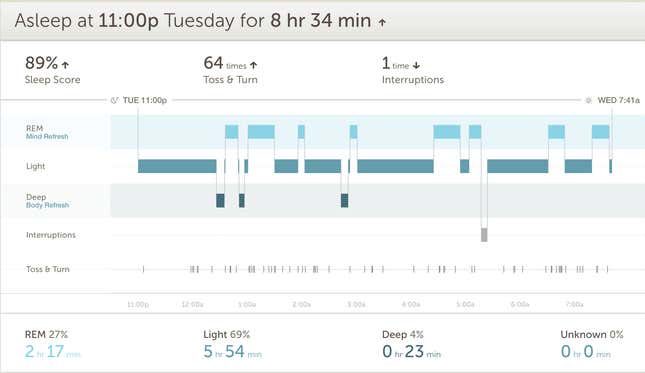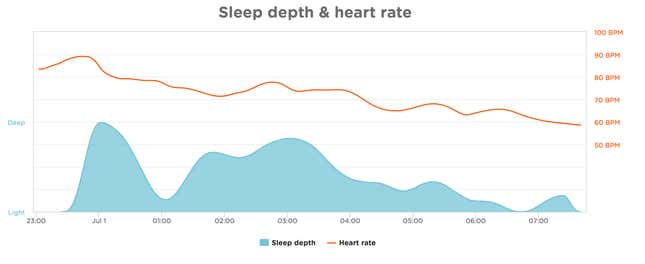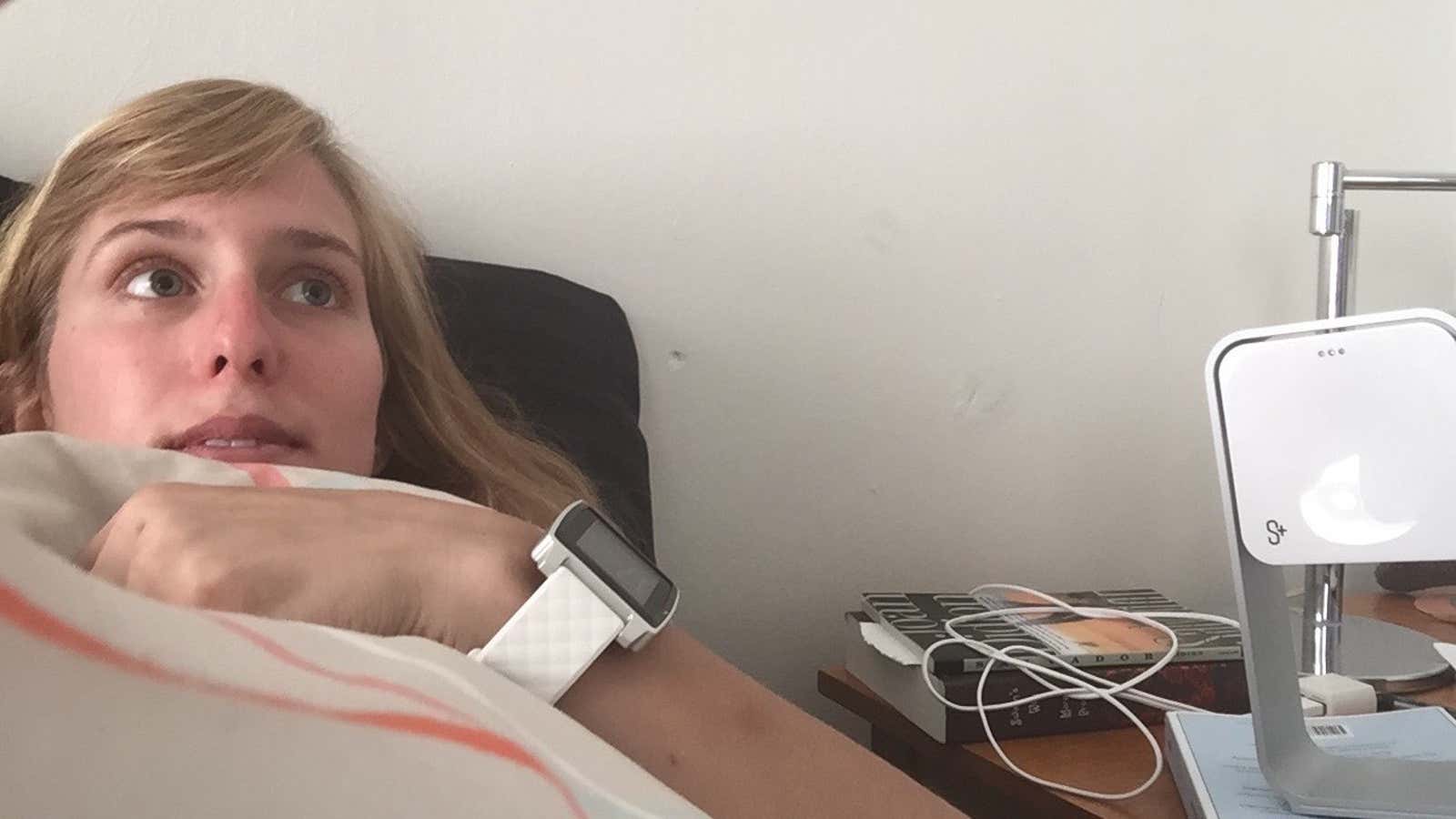In the future, we’ll outsource the burden of sleeping to our devices; we’ll lie on induction-charging mats for mere minutes and sit up, rejuvenated, perfectly calibrated to go out into the world and produce and consume. Until then, though, we’ll have to make do with letting those devices watch us sleep and then, when we wake, making sense of the measurements that’ll supposedly help us sleep better.
On and off for several months, I’ve tracked my sleep. The longest period of continuously monitored sleep stretched from late January, when I frequently woke in long sleeves to ice on the inside of my windows, to late February, when the ice was still there but I had switched to t-shirts.
I used three devices: The Beddit, a thin strip of sensor, stuck to my mattress, that measures heart rate, breathing, and movement; the Resmed S+, a concave white box that watches those same three things from a bedside table; and the Basis Peak, an activity-tracking watch that collects pulse, skin temperature, perspiration, and motion. I wanted as much data as possible, numbers to compare not only to how I felt in the mornings (never good, never ready) but to each other, relying on the illogical idea that the average of these sleep scores was the true one, the one that was a public and publicly understandable answer to the question “How did you sleep last night?”
The magical promise of data
In the realm of the quantified self, sleep is the final frontier. Not only is sleep much more difficult to measure than our waking activities, we also know so much less about it. Yet we’ve always wanted meaning from sleep, that unknowable same-looking thing we do every night. We ignore how difficult it is to even qualitatively track sleep in the first place, since one of its defining characteristics is being unconscious and, for the most part, unaware of what you’re doing.
So the promise of illuminating sleep with consumer sleep monitors is all the more enticing. There are watches and orbs and stickers, and they promise to watch us when we can’t. This is the way we sleep in the age of networks: Monitored, networked not to others but to ourselves. Hours slept are the obvious and common metric. But as everyone knows, my eight hours doesn’t leave me feeling the way your eight hours does; my eight hours doesn’t even leave me feeling the same way every time. We need more.
Enter sleep stages, either four or five of them, depending on whom you ask, ranging from light and deep non-REM sleep, when the brain consolidates memories and the body repairs and grows tissue, to REM sleep, when the brain produces those weird stories we call dreams and the body increases its production of proteins. We know a lot less about what happens during the stages than about when the stages appear, which we can watch via polysomnography—basically a collection of measurements: Brain activity, eye movement, heart rate, muscle movement, blood oxygen level, breathing, sound.
A polysomnogram of a sleep unencumbered by a sleep disorder will generally reveal sleep moving through the stages in 90-minute cycles, with more deep sleep in the first half of the night and more REM sleep in the second half. Together, these cycles, and the stages within, form the measure of a night. Accurate measurement of sleep stages is deeply useful for diagnosing sleep disorders. When it shows that there’s something distinctly wrong, it sometimes leads to a tool—a breathing mask, a medicine—to make what’s wrong slightly, if not distinctly, more right.
The data become fuzzier when it comes to consumer sleep trackers, which are rough substitutes, at best.They don’t qualify as medical devices, since they’re usually not as accurate as sleep lab technology, though sleep-tracker companies beg to differ, some with impressive data comparisons to back up their claims. These kinds of trackers are often used by people who have totally healthy sleep. The question is: Why?
I’m not entirely sure what insights they’re hoping to find, as I fall into the category of those with disordered sleep. According to which doctor I ask, it’s either narcolepsy or idiopathic hypersomnia (“unexplained super-sleepiness”—unpoetic, unsatisfying, but, oddly, descriptive), similar conditions with different sleep-study results to justify real, insurance-satisfying diagnoses. So I came, at first, to the project of tracking my sleep for a different reason: Not to try to improve it, which I suspect isn’t especially likely, but to find a better name—that is, a more stable one, a single straightforward diagnosis—for what’s wrong with it in the first place.
Though I’ve had three official sleep studies, each with a report of the night and the following day’s five scheduled naps, I don’t have the actual hypnograms, the graphs of my movement through the stages of sleep. Medicine may be putatively growing more transparent, with online access to records and insurance, but both are often tied in jargon-knots so complex that the information only seems substantive when it’s really about as superficial as what a doctor might say in a single sentence: You owe me money; you’re very tired.
These at-home sleep trackers gave me, albeit with far less accuracy, hypnograms, a stand-in for the real ones that were the source of unhelpful sentences like “evidence of excessive daytime sleepiness” and “sleep architecture was fragmented by numerous arousals of unclear etiology.” Perhaps, I thought, when setting out on my quest, I could understand something new. I’m no doctor, but I know narcolepsy when I see it, I told myself; I have the internet, after all.
Self-improvement
Every time I get a new data set about myself (i.e. from myself), I have a sliver of hope that in the charts and numbers I’ll see the source: I’ll see myself. And like studying my face in a video, with its uncanny right-left flip—how the world sees me, but the reverse of how I usually see me, in mirrors—this one will reveal some truth I just need a new vantage point to see. Yet I’m not quite tricked by the illusion that a chunk of sleep artificially frozen on a graph as “deep” means anything other than that a device categorized it that way, or that my laughter in a video means anything more than that was how the light was reflected and the sound waves captured while the shutter was held open. Both rely, in other words, on interpretation.
I don’t entirely mind. I still want a good night’s sleep recorded, and more importantly, I want evidence of it. If I don’t feel well-rested but the data say I should, then maybe I can convince myself I’m wrong. Maybe I could keep up the act, at least until it grows too exhausting.
Needless to say, I found nothing substantive from my measured nights, no revelations in the maybe-accurate data, no sense of self—because that’s what a real diagnosis had become for me—in the movement from deep to light to REM sleep and back again. All I found is that I get far less deep sleep than any of the apps say is normal.



Maybe I wasn’t trying hard enough. Towards the end of my latest bout of tracking, I thought maybe I should use the data to do what a “normal” person would: To glean some insight from myself about how to better myself, use the past data to make adjustments that would be borne out in future numbers, put my effort into living a measured present so the future would come out not just measured but better.
This notion of data-driven improvement is what drives the whole quantified-self movement: Measure the uncertain present to gain control over the future, which will be better in part because it’s more certain, in part because it’ll yield more data, and the feedback loop will go on. There’s a paradox at the heart of this thinking: A supposedly objective measure is the only way to find an accurate version of the subjective self, and finding it will make us feel subjectively less uncertain. To know the true self, you have to replace it with data, piece by piece, until every part of identity can be traced to a particular measurement, until the whole thing is mediated by computers, those machines we trust more than ourselves because they’re here with a purpose, not just by chance.
Unable to fully accept this, I still wondered, every morning, when I tapped the button on my phone screen that says “stop sleeping,” what’s more real—the way I feel when I wake up, or the way the app’s sleep score tells me I feel.
Real or not, my measured sleep was certainly entertaining, albeit in a somewhat obsessive, counting-steps-walked kind of way. I no longer needed to look outward, adding the context of the real world, to better understand myself. I was content creator and content audience, the joyful recipient of the knowledge that it’s true that alcohol before bed decreases REM sleep in the first half of the night, that the feeling of having dreamt the whole night tends to align with mornings when my alarm woke me during REM sleep. Even the discrepancies between trackers—when I first enter deep sleep, how many times a night I wake up, whether I’m in dream sleep when I wake in the morning—held entertainment value, since they added room for interpretation, and who doesn’t like telling a good story?
Besides providing entertainment, these trackers make sleeping practical. Each measured night (I’m still tracking, sometimes; it’s still fun) provides a task for the day: Make the next night’s sleep better. Sleep becomes productive, a catalyst for changing my waking habits. I’ll make adjustments to my day—more fruits and vegetables, more “mindfulness” in the evening hours, for instance, in order to achieve “better” data at night. That will in turn affect my nights, making me sleep more efficiently, which will make me more productive during the day, and so on, until the cycle has been calibrated just so to make me an efficient and productive person. (And I ignore that sometimes I won’t track a night because I don’t want it to “count.”)
To get there, every night before turning on the monitors, I tell myself I’ll add context in the morning: I’ll say when I went to sleep after spending the better part of the day at home, in house pants; I’ll admit when I’ve had above the recommended daily amount of alcohol for a woman or a man; I’ll note when there was someone else in my bed (there never was—it’s never too late to introduce sleep-tracking to a relationship). But come morning, I never do. It’s too much work. Plus, I wake up ravenous, and by the time I’ve finished my English muffin, there’s something else on my mind.
By the time I look at the data, narcissism, and the corresponding need for a stable, certain identity, for seeing myself clearly everywhere, is enough to justify not adding information that could make the results any more complicated. I like certainty wherever I can get it, and there’s a perverse sense of pleasure in seeing that I got only 19 minutes of deep sleep last night. It’s not that this number validates or invalidates any sleep-disorder diagnosis—for now, I’ve given up on that project—but rather that it validates what I did during those unconscious, formerly unknowable hours. I created data; I was productive. And because I’m a proper millennial, this doesn’t necessarily feel good, but it feels right.
